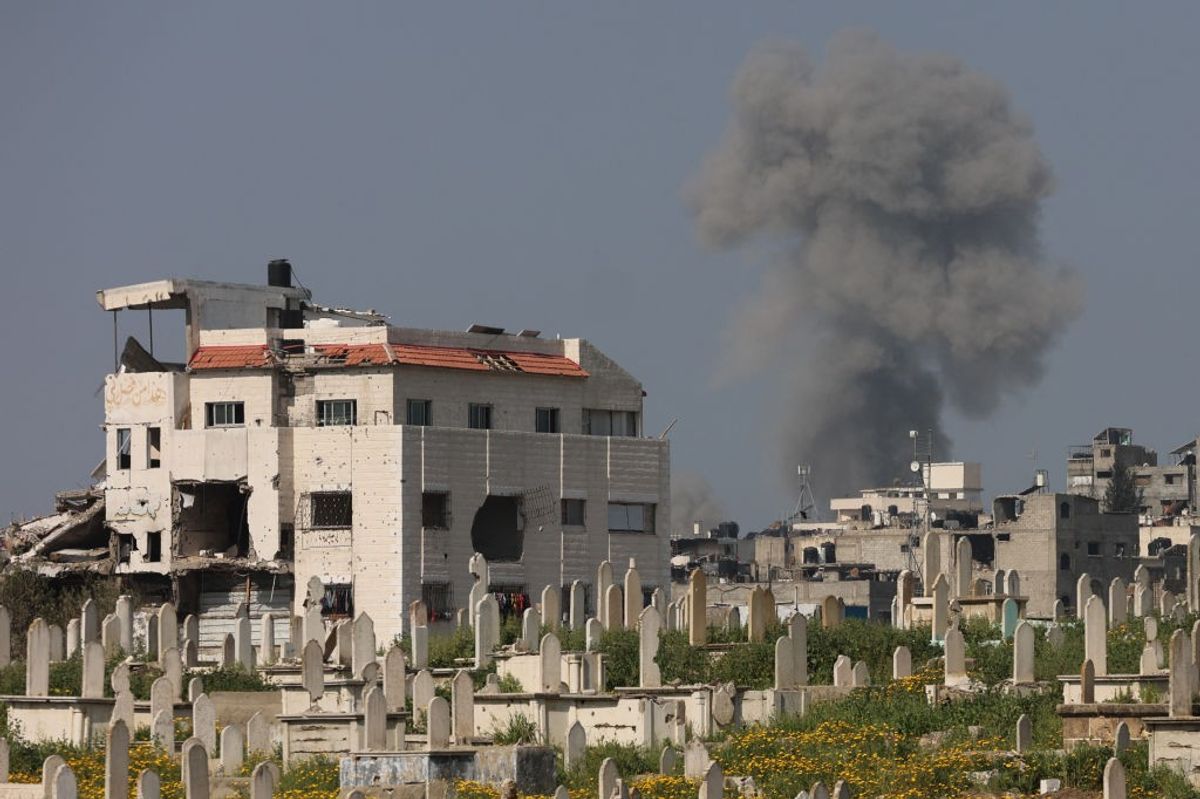DEEP DIVE — Amid all the uncertainty that has followed the fall of the Assad regime in Syria, one issue ranks highest for the U.S. and other countries: the potential resurgence of militant groups in the country, and in particular, a renaissance of ISIS.
The name itself is a reminder of the group’s recent history and geography. “ISIS” stands for Islamic State in Iraq and Syria – and its battlefield success in Syria a decade ago led to a U.S. military deployment, and a mission that ended the group’s bid to create a new caliphate. The Obama and Trump administrations both claimed victories against ISIS, but both also agreed to maintain a military presence in Syria; roughly 900 American troops remain there today.
The current U.S. concerns were clear in the White House response to the rebellion: a mix of cheering for the ouster of Bashar al-Assad and his brutal dictatorship, and a flurry of airstrikes against ISIS targets in Syria.
On December 8, less than 24 hours after the Hayat Tharir al-Sham (HTS) coalition of rebel groups captured the Syrian capital, Damascus, U.S. aircraft struck more than 75 ISIS targets across central Syria, in what President Joe Biden said was an effort to ensure that the Islamic State could not reconstitute its power after Assad’s fall.
“We’re clear-eyed about the fact that ISIS will try to take advantage of any vacuum to reestablish its capability, to create a safe haven,” Biden said. “We will not let that happen.”
A day later, U.S. Central Command (USCENTCOM) Commander General Michael Kurilla visited U.S. forces and members of the Kurdish-led Syrian Democratic Forces (SDF) at bases in Syria. The SDF is the main Syrian partner in the U.S.-led “Defeat ISIS” coalition.
“There should be no doubt — we will not allow ISIS to reconstitute and take advantage of the current situation in Syria,” Gen. Kurilla said. "All organizations in Syria should know that we will hold them accountable if they partner with or support ISIS in any way."
The American attacks have continued – on Monday, the U.S. said a new round of strikes had killed 12 Islamic State fighters in Syria. A USCENTCOM statement said the strikes targeted “ISIS leaders, operatives and camps… as part of the ongoing mission to disrupt, degrade and defeat ISIS.”
A decade ago, ISIS took advantage of civil strife in Syria and a weak government in Iraq to capture swaths of territory. The question now is, will it take advantage of a power vacuum in Syria to strike again?
“The idea of Islamic militants in charge of such central geography would be a terrific and consequential complication for the region,” Norman Roule, a former National Intelligence Manager for Iran at the ODNI, told The Cipher Brief. “Touching countries such as Saudi Arabia, Israel, Turkey, Jordan – I mean, the list just goes on and on and on of why you would want stability in Syria.”
The good news, for now, is that the HTS rebels, who were once linked to Al Qaeda, are sworn enemies of ISIS and have fought against the group in northern Syria. Their leader, Abu Mohammad al-Golani, “appears to have taken a more pragmatic approach” in the last 5 to 10 years and forsworn militant Islam, said Ambassador Gary Grappo, a Cipher Brief expert and long-serving diplomat in the Middle East. “And some initial signs suggest that maybe he has followed up on that. He's issued warnings and announcements about respecting Christians, the Alawites, Kurds, and others.”
But there are other causes for concern, all stemming from one undeniable fact: the lightning fast rebellion has left a vacuum of power and authority in Syria, especially outside the capital and other major cities.
And while experts differ on the true aims of the HTS coalition, no one doubts the aims and ambitions of ISIS. The group has never wavered from its dream of creating a new caliphate in the region, and it has shown its willingness to use violence and terror to further that mission.
"ISIS never disappeared. It fragmented," Tom Mockaitis, a Professor of History and Terrorism Expert at DePaul University, told The Cipher Brief. "Its Islamist ideology persists and continues to inspire followers, many of whom live in Europe and throughout the Middle East and North Africa.”
ISIS ascendant – and the U.S. mission
Well before the fall of the Assad regime, there were signs that ISIS was regaining strength.
In July, the Pentagon warned that Islamic State attacks in Syria and Iraq were on track to double the previous year’s figure. Charles Lister, Director of the Syria and Countering Terrorism & Extremism programs at the Middle East Institute, said this week that the reality was worse; by his count, ISIS has carried out nearly 700 attacks in Syria since January, a tripling of last year’s number. In an Op-Ed in The New York Times this weekend, Lister said that the sophistication, deadliness and geographic spread of ISIS attacks have also surged.
According to the Syrian Observatory for Human Rights, last Tuesday – just two days after Assad’s ouster – Islamic State forces killed 54 people in the central Syria who had been associated with the regime’s military and were trying to flee the country. Lister and others also note that ISIS has tried repeatedly to free its operatives from prisons in northern Syria, and they assume the group will try again, given the current instability.
There is “cause for alarm,” Lister wrote. “At this precarious moment in Syria’s history, urgent steps are required to ensure that progress is not lost.”
For all these reasons, the U.S. has said that the 900 American troops will remain in Syria.
“Those troops are there for a very specific and important reason, not as some sort of bargaining chip,” Deputy National Security Advisor Finer said at last week’s Reuters NEXT conference. U.S. troops “have been there now for the better part of a decade or more to fight ISIS,” he added. “We are still committed to that mission."
There are at least two potential problems with that pledge.
The first is that there have already been signs of trouble for the SDF, the key American partner on the ground in Syria and the group that watches over thousands of ISIS prisoners. Turkey has a longstanding animosity for the group, and in the past week, the Turkish-backed Syrian National Army group (SNA) has captured key towns from the SDF.
The U.S. is concerned that the SDF may lose control over al-Hol refugee camp in northern Syria, where many of the ISIS fighters are being held.
“Right now the concern is that if the Turks or their proxies…go after the Kurds, this will weaken the Kurds' ability to control al-Hol,” said Glenn Corn, a Cipher Brief expert and former Senior CIA Officer. “That's the argument that the Kurds have made. The Turks, I think, are going to try to make it clear that they are in a position to secure that area and that they also have no interest in letting ISIS expand or reform in any sizable manner, because it's a threat to Turkey as well.”
The other issue for the anti-ISIS alliance, and the pledge to keep those American troops in Syria, involves the transition in Washington. Among President-elect Trump’s nominees to key national security positions, there is a strong constituency for drawing down American overseas commitments, and Trump himself has said the U.S. should have “nothing to do” with Syria’s future. There may be an internal tension in the next administration between that view, and a desire to contain ISIS in Syria and elsewhere.
“Our troops…paired with our SDF partners are there to keep a lid on ISIS and prevent violent extremist organizations from gathering strength and being able to attack the homeland of the United States,” Gen. Frank McKenzie, a Cipher Brief expert and former head of U.S. Central Command, said on the day the Assad regime was overthrown.
“That's why those troops are there,” Gen. McKenzie said. “So any decision to bring them out, we'd need to weigh that going forward, and I'm certain that the new administration will take a hard look at that when they come into office.”
The state of ISIS - and the recent history
The United States has spent nearly a decade combating ISIS in Syria and Iraq, in a largely successful partnership with the SDF. Today most of ISIS’s leaders in Syria are believed to be in hiding.
Those who fear an ISIS resurgence point to the recent successes of another Islamic State franchise, IS Khorasan, or IS-K, which operates from safe havens in Afghanistan and has managed in this year alone to carry out a major terror attack on the outskirts of Moscow, another in Iran, and plotted – without success – attacks against a Taylor Swift concert in Vienna and against sites in the U.S. on Election Day.
The worry is that the conditions that have made Afghanistan a comfortable home for Islamic State – relative safety, young recruits, and poor governance and security – may be replicated in a post-Assad Syria.
"There's always a reason to be concerned about an ISIS resurgence, even if few believe ISIS can ever reconstitute a physical caliphate similar to what it had created in 2014-2019," Colin Clarke, Director of Research at The Soufan Group, told The Cipher Brief – before the overthrow of Assad.
"It matters to Washington because when ISIS can control territory, it has the operational space to maneuver and pump out propaganda at a higher frequency,” Clarke said. “This can lead to an uptick in 'inspired attacks' by homegrown violent extremists in the West, including in the U.S."
There is at least one more issue common to the situations in Afghanistan and Syria, and wherever else Islamic militants seek new recruits: the long and deadly war in Gaza. That conflict – and the huge toll it has taken on Palestinian civilians – has been an inspiration for these groups and their followers. At this year’s Cipher Brief 2024 Threat Conference, the U.S. acting director of counterterrorism Brett Holmgren said that at the one-year anniversary of the October 7 Hamas attacks, there had been at least 19 global terror attacks and 21 disrupted plots tied directly to the conflict. Holmgren said “the Israel-Hamas conflict is emerging as the most consequential event impacting global terrorism in the last decade.”
Veryan Khan, President and CEO of the Terrorism Research & Analysis Consortium (TRAC), told The Cipher Brief that “since October 7, [2023], the amount of propaganda encouraging retribution attacks is at an all-time high."
Lister, the Syria Program Director at the Middle East Institute, believes a blend of military action and diplomacy is needed “to prevent ISIS from filling vacuums left by President Bashar al-Assad’s fall. The United States and its allies must use every tool available to fight its resurgence.”
Specifically, Lister said, the U.S. should carry out strikes when and where ISIS seeks to amass resources, regroup or launch attacks; and the U.S. and other nations should press diplomacy involving the rebels and the government of Turkey, which as Lister said – and The Cipher Brief has reported – “holds many of the keys in this conflict.”
Read more expert-driven national security insights, perspective and analysis in The Cipher Brief.















